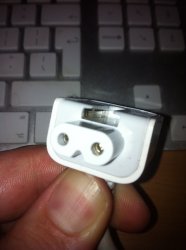This thread is full of info beyond my comprehension.
What is the purpose of grounding your MBP? I use the 2 prong mostly, I don't bother with the extension (which includes the 3 prong).
Good explanation here:
http://www.epanorama.net/documents/groundloop/why_grounding.html
I've copied most of it below for easy reading:
"A Grounding system has three main purposes:
1. Overvoltage protection
Lightning, line surges or unintentional contact with higher voltage lines can cause dangerously high voltages to the electrical distribution system wires. Grounding provides an alternative path around the electrical system of your home or workplace minimizes damage from such occurances.
2. Voltage stabilization
There are many sources of electricity. Every transformer can be considered a separate source. If there were not a common reference point for all these voltage sources it would be extremely difficult to calculate their relationships to each other. The earth is the most omnipresent conductive surface, and so it was adopted in the very beginnings of electrical deistirution systems as a nearly universal standard for all electric systems.
3. Current path in order to facilitate the operation of overcurrent devices
This purpose of grounding is the most important one to understand. Grounding system provides certain level of safety to humans and property in case of equipment damages.
Grounding operation in electrical distribution network
The main reason why grounding is used in electrical distribution network is the safety: when all metallic parts in electrical equipments are grounded then if the insulation inside the equipments fails there are no dangerous voltages present in the equipment case. Then the live wire touches the grounded case then the circuit is effectively shorted and fuse will immediatly blow. When the fuse is blown then the dangerous voltages are away.
The safety is the primary function of grounding. Grounding systems are designed so that they do provide the necessary safety functions. Grounding also have other functions in some applications but the safety should not be compromised in any case. Grounding is quite often used to provide common ground reference potential for all equipments but the existing building grounding systems might not provide good enough ground potential for all equipments which might lead to ground potential difference and ground loop problems which are common problems in computer networks and audio/video systems.
How electric shock happens
The "hot" wire is at 120 volts or 230 volts (depends on the mains voltage used in your country) and the other wire is neutral or ground. If a person were to touch the neutral wire only, no shock would result simply because there is no voltage on it. If he were to touch the hot wire only, again nothing would happen to him unless some other part of his body were to become grounded. A person is considered to be grounded if he comes in contact with a water pipe, metal conduit, the neutral or ground wire, or stands barefoot on a concrete floor.
In other words, neither wire is a shock hazard unless a person is grounded, and then only the hot is a potential shock hazard. Of course, if a person were to touch both wires at the same time, he would be shocked simply because his body is completing connection between "hot" and "ground" wires.
Grounding in wiring
Today's modern (US.) mains cable consists of three separate wires: black, white, and green. The green wire is always connected to the large ground pin on the plug, and the other (green) end connected to the chassis of the equipment. The black wire is always considered to be the "hot wire," and as such, is always the leg which is connected to the switch and fuse. The white wire is always the neutral or common wire.
European coloring is a little bit different. The ground wire is here green wire with yellow stripe. Neutral wire is blue. Live wire in Brown (additional colors for the live wires used in 3 phase systems are black and black with white stripe).
Any modification of the above 3 wire mains system completely eliminates the protection given by the three wire configuration. The integrity of the separate ground path is also directly related to the quality of the receptacle and the wiring system in the building itself.
The neutral (grounded conductor) must be solidly connected (bonded) to the home's ground system at the first disconnect (main panel). This keeps large voltage differences from developing between the neutral and ground."
Which country has the best electrical system?
The one with the most up to date electrical wiring across its lands











